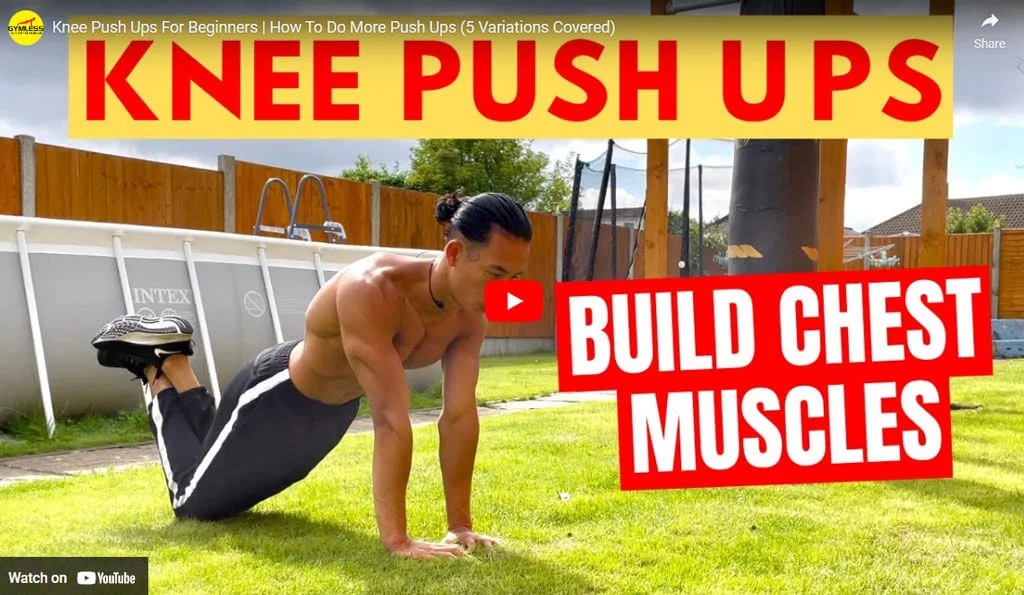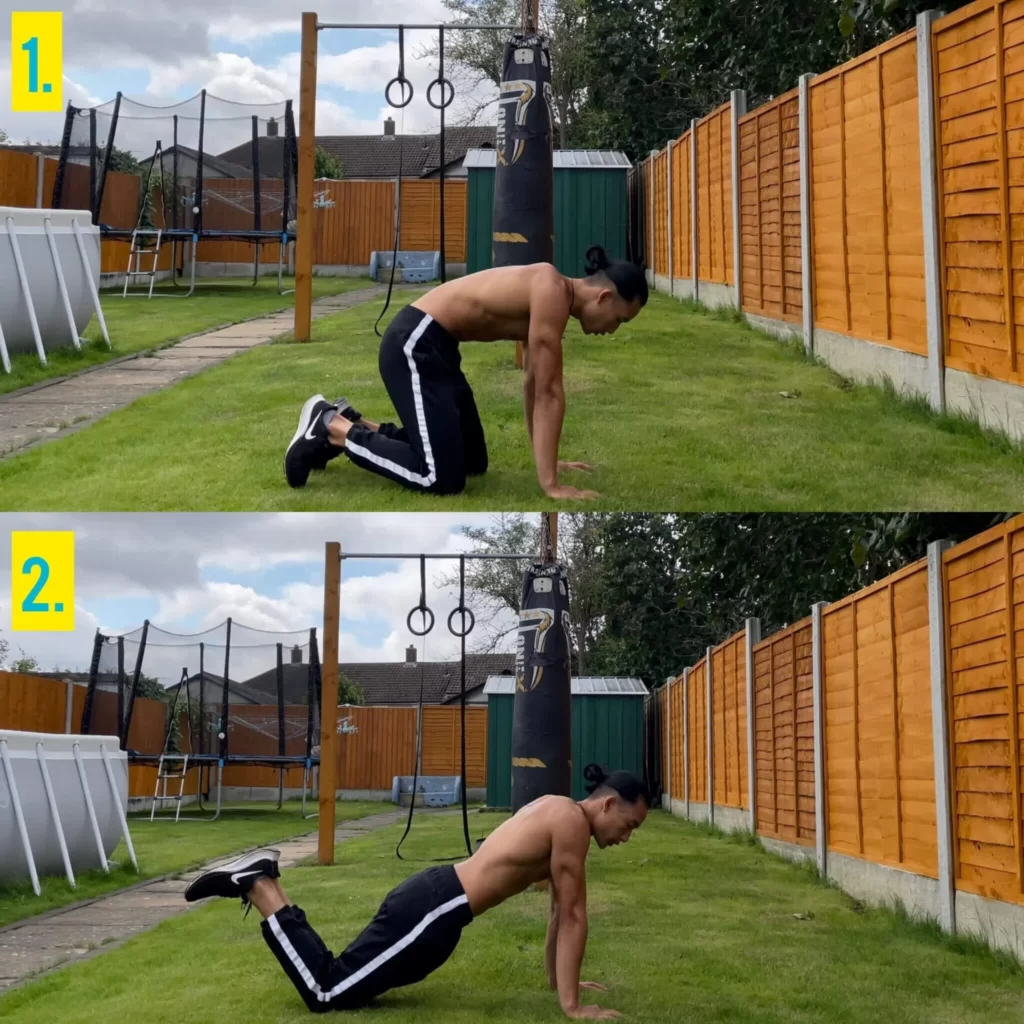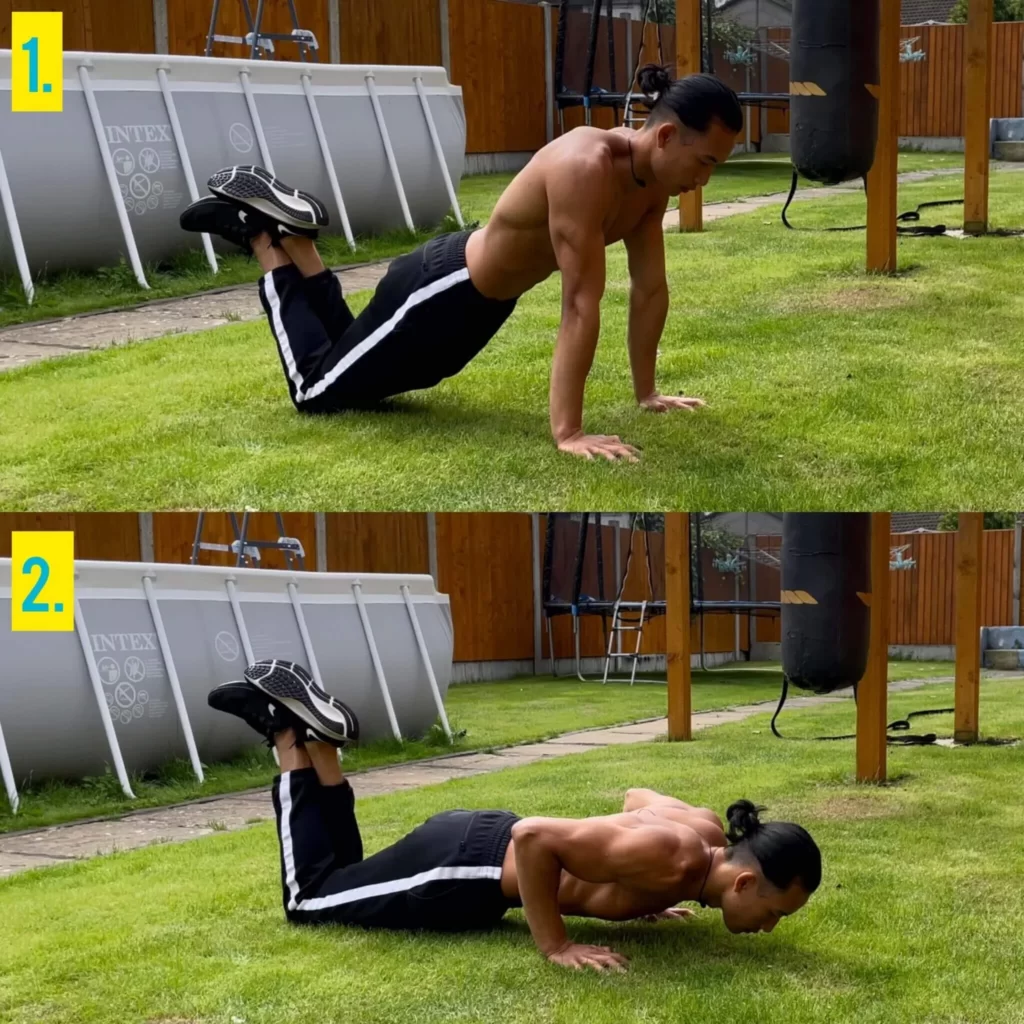
Table of Contents
What Are Knee Push Ups?
The knee push-up is a bodyweight pushing exercise that will develop your upper body strength towards achieving the full push-up. This exercise targets the same muscle groups and has the same movement path as the standard push-up, therefore you will reap the same benefits from this regression exercise.
As the name suggests, you’ll be on your knees and this will make the movement easier there will be less load on your upper body muscles. If you’re new to push-ups then this is a great strengthening exercise to practice as it will develop your chest and triceps muscles.
What Muscles Are Worked by Knee Push Ups?
The primary muscles worked are the pectoralis major, triceps, and anterior deltoids. The secondary muscle groups worked are the abdominals, obliques, serratus anterior, glutes, and quadriceps.
What Level are Knee Push Ups?
The knee push-up is a great exercise for beginners who want to develop their chest and triceps muscles. They are easier as when you’re on your knees you’re pushing less body weight in comparison to when being on your toes. Simply put, there is less load on your upper body muscles for knee push-ups.
Are Knee Push Ups Effective?
Knee push-ups are an invaluable alternative to traditional push-ups for the purpose of building strength in your chest, shoulder, and arms while simultaneously strengthening the core muscles. Research reported that suspended push-ups provide greater activation of the abdominal muscles in comparison with standard push-ups.
How to do Knee Push Ups
2. Get on All Fours
Start by getting on all fours, placing your hands on the ground shoulder-width apart. Your shoulders are stacked directly on top of your wrists, and your knees are together and extended back. Engage your core and glutes to maintain a straight line. This is your starting position.

2. Gradually Lower Down
Inhale through your nose as your lower your chest down towards the ground until your elbows are approximately at 90 degrees angle. Elbows are drawn in towards your torso rather than flaring out. Engage your core the entire movement.

3. Gradually Push Up
Exhale through your mouth and push back up to the starting position. Squeeze your chest, core, and triceps at the top position. Lock both arms out fully before repeating to ensure a full range of motion.

4. Repeat
Repeat this movement for 3-10 reps for 4 sets. Train this 3 times a week. Stay between this range for 2-3 weeks and gradually increase 1-2 reps, as well as sets to ensure progressive overload.

What are the Benefits of Knee Push Ups?
Improved Upper Body Strength
Knee push up are a compound exercise which means that many muscle groups are being worked at the same time to perform a single movement. Your chest, triceps, shoulders, and core will be activated. Training these consistently will improve your upper body strength, and it will surely make you look more toned and sculpted.
Improve Core Strength and Stability
This exercise recruits your core muscles as a stabilizer to prevent your body from toppling over. Targeting the core will enhance the microscopic nerves to be more responsive to stimulation, which will help the whole unit of your core become stronger and more stable.
No Equipment Needed
Knee push-ups are free to do as all you’ll need is your body as resistance and some space. You can get a great upper body workout from doing just push-ups! There are more variations to the knee push-up that is covered below. Therefore, you can target many angles of your chest by doing different variations.
Knee Push Ups Variations
Wall Push Ups
Wall push-ups target your chest, triceps, back, and shoulders. This exercise is a great starting point if you are not yet able to do knee push-ups, as most of the load will be on your feet rather than your upper body. To perform this, you will:
- Stand tall with your body being 2 feet from a wall. Your arms are straight in front of you at shoulder-width, and your shoulders are in line with your hands. This is the starting position.
- Inhale and bend your elbows as you lean your body as close as you can toward the wall. If you feel you’re reaching too far, move your feet close to the wall.
- Exhale and push back to the starting position. Aim to perform 5-12 reps for 4 sets.

You can experiment with your hand position to target different muscle groups and different sections of the muscle. The shoulder-width grip targets the middle chest and triceps. The diamond grip will limit the involvement of the chest and isolate the triceps. The wide grip targets the outer chest, shoulders, and back.

Diamond Knee Push Ups
This variation is a progression to the knee push-ups as you will form a diamond/triangle shape with your hands located at the center of your chest. This will put more stress on the triceps and limit the involvement of the chest. Your balance point will be smaller which will recruit your core more. To perform this, you will:
- Get on all fours with your hands at the center of your chest in a diamond/triangle shape (connect your index fingers together, as well as your thumbs). Shoulders stacked on top of your wrists. Extend your knees back and engage your core and glutes to maintain a straight line. This is your starting position.
- Inhale and gradually lower down until elbows are parallel to the floor. Keep your core engaged the entire movement.
- Exhale and push back up to the starting position. Lock both of your arms out to ensure a full range of motion.
- Repeat this movement between 3-10 reps for 4 sets.

Negative Push Ups
Negative push-ups are similar to traditional push-ups, but the difference is that you will focus on the lowering down part with as much control as possible. This is also known as the eccentric part. Doing this will increase time under tension for your muscles which will develop strength and endurance for the full push-up. To perform this, you will:
- Get into a plank position where your hands are shoulder-width apart and shoulders stacked on top of your wrists. Legs are fully extended and feet are together. Engage your core to maintain a straight line. This is your starting position.
- Inhale and gradually lower your chest down towards the ground, counting 3 seconds as you do so. Focus on engaging your core and glutes as well as chest and triceps activation.
- Lean back into a child’s pose position and return to the starting position and repeat this movement. Aim to perform this between 2-6 reps for 4 sets.

Push Ups
Push-ups would be your ultimate goal. It is progression as more load will be placed on the upper body. Practicing previous progressions will develop your muscle strength and endurance in the upper body to enable you to perform a push up. To perform this, you will:
- Get into a plank position where your hands are shoulder-width apart and shoulders stacked on top of your wrists. Legs are fully extended and feet are together. Engage your core to maintain a straight line. This is your starting position.
- Inhale and gradually lower down until your elbows are parallel to the floor. Keep your elbows close to your torso. Squeeze your chest and triceps at the top position.
- Exhale and push back up to the starting position. Extend both arms out fully before repeating to ensure a full range of motion.
- Repeat. Aim to do this movement between 3-10 reps for 4 sets
For a comprehensive guide that looks into the proper form and progressions to unlock this exercise, check out this standard push-ups tutorial.

The Takeaways: Knee Push Ups
Knee push-ups and push-ups, in general, are great upper-body exercises that build strength in your chest, triceps, shoulders, and core. Practice this consistently along with other knee push-up variations and you’ll soon be able to do push-ups on your toes. Pat Chadwick recommends that once a person is confident doing 12 knee push-ups, then they are ready to try standard push-ups.
If you’ve enjoyed reading this guide then you might also be interested in our follow-along chest workouts:
We regularly post fitness on our main social media platforms; Instagram, TikTok, and YouTube. Please give us a follow to stay up to date with the latest fitness tutorials and you can always contact us anytime!
All Push Exercises

I’m Pat Chadwick, a qualified Level 2 and Level 3 calisthenics coach and certified personal trainer from London, England. I have over six years of experience training students specifically in the art of calisthenics. I’ve competed in various UK competitions, including the Kalos Stenos Championships, where I achieved third place in the lightweight category. My passion is highlighting the beauty of calisthenics as an authentic and pure form of body expression. I believe that everyone has the potential to become a champion of their body and mind, and that calisthenics opens the door to personal empowerment.


Leave a Reply